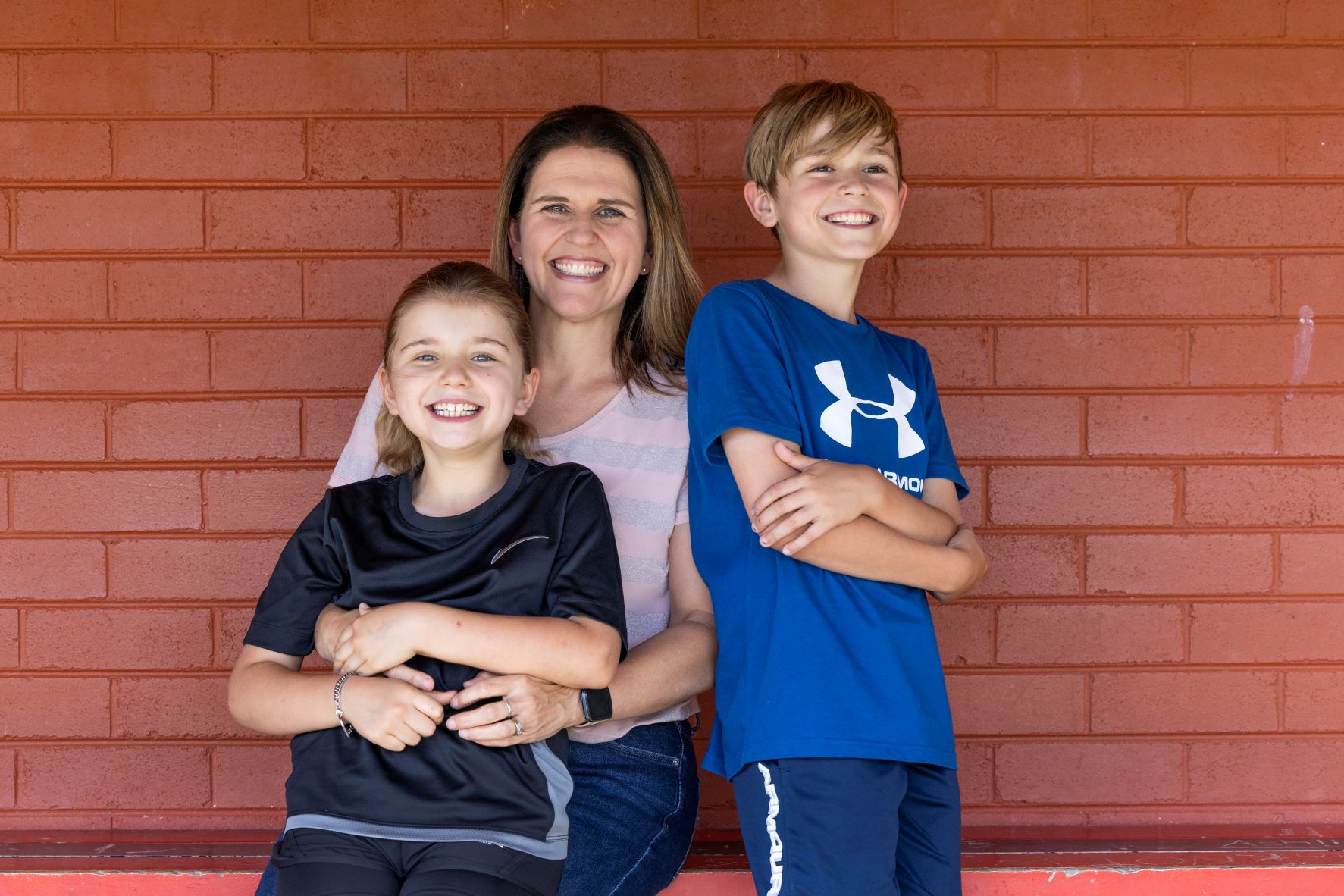Local mum Kathryn hasn’t had a single day off since her son Ethan was 26 months old. Days off from work, yes, but worrying about her two children’s life-threatening illness? Not a chance.
In a game of medical condition roulette, Kathryn came out at a loss – two of her children were diagnosed with Type 1 Diabetes (T1D) when they were just toddlers.
“If I’m honest, it feels a bit unfair to have two kids with T1D and I feel heartbroken for them. I can’t just let them be little kids and enjoy every aspect of their life without the burden of it,” Kathryn says.
Describing what it feels like to have a child with such a complex and incurable condition is not an easy task for Kathryn, but the best word she could find is “unrelenting”.
“In a nutshell, it’s unrelenting. Just so constant and not a minute goes by of every day where I’m not thinking about blood sugar. There’re no days off – birthdays, Christmas, all through the night and day… it’s intense,” she reveals.
Her son Ethan, now 11, was diagnosed when he was just 26 months old, and her daughter MJ, who’s almost nine, was only 22 months old.
“These kids did nothing to deserve getting T1D. They were babies! They hadn’t eaten too much sugar, they hadn’t even had a sip of soft drink, their bodies just betrayed them and caused an autoimmune reaction that stopped their pancreases producing insulin,” says Kathryn, pain evident in her voice.
“With Ethan, we came pretty close to losing him. I’d just given birth to MJ and Ethan was hungry and thirsty every minute of the day, he was dropping all his pudginess and getting so thin we had to go down a size in nappies. Our GP let us down, they kept saying he had an ear infection, a virus, this and that, to let him rest and keep up fluids,” recalls Kathryn.
“It wasn’t until one horrible Saturday we noticed him drifting in and out of consciousness – he was so sick. We took him back to the doctors and saw a different GP who took one look at him and said, ‘that child has Type 1 Diabetes, you need to take him to the hospital, now’.
“That was a really, really rough patch. He was in intensive care and it was just touch and go. We had conversations about whether he had organ failure and we thought we were going to lose him. That was the 27th of April – and it was the day all spontaneity in our lives died.”
Ethan was too young to have any memories from that day, but for the rest of Kathryn’s family the trauma still haunts them.
With MJ, she remembers getting ready for work one morning, and the 22-month-old screaming for Weet-Bix, giving her a flashback to Ethan at that age. Pricking her finger and seeing the number 9.8 made Kathryn’s knees buckle, and she fell to the floor. How could this be happening a second time?

“I called the hospital and they said they’re getting a bed made up. She was much healthier and didn’t need all the time in hospital that Ethan did. It just stung a bit more because I knew how hard it was going to be,” says Kathryn.
“The good thing though, if I have to find a positive, is that they have each other for support. I don’t know what it feels like to be low, but both of them do. They encourage each other when they have to have their cannular changed every two days because it hurts, and they give each other tips and pointers to get through it.
“The silver lining is they have a friend who truly gets it. They’re so brave, strong, and resilient. Some days have been absolutely horrendous and they’re just fighters – they get back up and do it all again.”
Kathryn has high hopes for both their futures – they’re very sporty and faster than all their peers. She laughs as she says kids at their school wish they had diabetes because “then I could run as fast as MJ and Ethan”.
However, one darkness does plague both MJ and Ethan’s futures, and it’s one that Kathryn says her eight-year-old daughter is already worrying about.
Both the kids use a Dexcom Glucose Monitoring System that Kathryn describes as a “gamechanger”. It’s attached to both her children, and Kathryn can see information about their blood sugar right from her phone. She can see it when they’re at school, her husband can check them while he’s at work, and it’s much easier than finger pricking Ethan and MJ constantly. In Kathryn’s eyes, it’s a necessity of life.
“Before Dexcom, it was dreadful. We had this tiny little boy, and we were so worried that we would prick him 10 to 15 times a day, because we just didn’t know where he was up to and he couldn’t tell us,” Kathryn remembers.
“One day we were running around the house and he flopped to the floor and said, ‘Mummy, why won’t my legs work?’ We checked him and he was at 2.2, which is very low, disastrously low. We would think if only there were a window that could tell us what his blood sugar was doing, and then we learnt about Dexcom.
“We put him on it straight away and we were paying $120 a week, and then we wouldn’t be without it for MJ, so that was $240 a week. I got really good at cooking meals that didn’t cost much and we cut every corner we could to afford them. My parents and my husband’s parents would try and help us out when they could, too.”
While Kathryn was chatting to CW, she excused herself to call out to Ethan, who was playing outside. She could see on her phone that he had forgotten to give himself insulin after his after-school snack.
“Without my phone telling me he forgot his insulin, I would have waited until dinner to prick him, and he would have been very, very high by then. Every high is doing him damage that will affect his future – his eyes, his heart, his kidneys,” she says.
“It might not be a very bright future because he might be on a dialysis machine. It [Dexcom] has kept both of them out of hospital for so many years. Having this technology, in my opinion, is completely necessary.”
“It might not be a very bright future because he might be on a dialysis machine. It [Dexcom] has kept both of them out of hospital for so many years. Having this technology, in my opinion, is completely necessary.”
In 2018, the government began subsiding the life-saving technology and both children were able to get it for free. Kathryn’s elation was indescribable, she was “over the moon”. To this day, she still feels thankful every time she goes to the chemist, picks up their Dexcom, and walks out the door without paying a cent.
The downside though to this wondrous gift is buried in the details. Once a child turns 18 or 21, they are no longer awarded the subsidy, and must begin paying for their life-saving machine.
“It’s too much to think about. It’s so heartbreaking to know my little ones are already worrying about the costs. I hope in my heart that the government will make it equitable. Every person with Type 1 Diabetes should have this technology,” says Kathryn.
“Without it, it’s awful. The wondering what’s happening with their sugars… we call it ‘flying blind’ without the monitoring system. We hate flying blind.
“If this was anyone else’s life, and I know it’s hard from the outside looking in, but they’d want it valued and giving glucose monitoring systems for everyone means they can live life a bit more normally. I hate the word ‘normal’ because what is that… but they can experience life the fullest they possibly can.”
Young Canberrans face inequities with glucose monitoring systems
A survey conducted by JDRF Australia shows in the ACT, there are 2,100 people living with T1D, and the total cost of the disease in the Territory will be $49 million this year. Out of this population:
- 840 people will have one or more complications this year
- 51 people will be hospitalised this year
- 425 people are living with T1D and haven’t yet been diagnosed
- The lifetime cost for those in the Territory is $840 million
- 420 people living with T1D experience clinical depression due to the disease
- 1,260 people in the Territory won’t have access to lifesaving technology
The survey results showed Australians with T1D are being forced to choose between financial security and life-saving technology, and Canberrans with the disease are calling for an abolishment of the “arbitrary age bracket”.
A campaign to remove these barriers, #AccessForAll, led by JDRF Australia, is charging forward ahead of the Federal election, and asking for a $100 million per year investment into diabetic technology.
Almost 90 per cent of Australians with T1D use a glucose monitoring system and say it’s a “game-changer” for their health and makes them feel more in control.
JDRF Australia CEO Mike Wilson says access to T1D technology shouldn’t be determined by your birthday or bank balance.
“It is not acceptable, equitable, or justifiable that access to these devices is dictated by age or wealth rather than need and benefit, or that the pathway for assessing innovative new treatments is complex, challenging, expensive, and time consuming,” Mr Wilson said.
“It’s a travesty that young Australians with T1D are having their subsidised access to this life-changing technology taken away as their 18th or 21st birthday present from the government.
“This is naturally a time of great change in many people’s lives as they look to forge careers, engage in study or experience greater independence, and the loss of the technology they’ve relied on up until this point is a recipe for complications that can have ongoing, lifelong, and life-altering impacts.”
Canberra Daily would love to hear from you about a story idea in the Canberra and surrounding region. Click here to submit a news tip.



